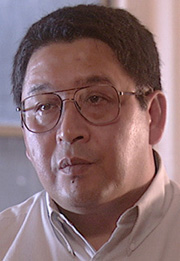Ali Mao Maalin[left], was a cook in Merca, Somalia. In 1977 Ali contracted smallpox,a deadly virus that has claimed millions of lives throughout humanhistory. But Ali's infection was different. According to the WorldHealth Organization, Ali was the last known case of smallpox on planetEarth. Ali's immune system successfully eradicated the last strain ofthis horribly infectious disease on 26th October 1977, forever riddingthe world of this virus... Or did it?Smallpox had quite a history. The first recorded casewas 2000 years ago in China. The Pharaoh Ramses V died of smallpox in1157 B.C.The disease reached Europe in 710 A.D. and was transferred to Americaby Hernando Cortez in 1520. It was so deadly that 3,500,000 Aztecs diedfrom it in the next 2 years. The virus behind many of Europe's darkplagues, smallpox killed five reigning European monarchs during the18th century.
The last known case of smallpox in the U.S. was in Texas in 1949.
With the heightened fear of bio-terrorism followingSeptember 11th, 2001, scientists have been trying to imagine potentialmicrobes that could be used by terrorists groups or individuals againstlarge populations, such as American cities. Smallpox, because of itsdeadly reputation and history, has become the prime focus of this fear.But is this fear justified?

Smallpox is usually contracted through inhaling the virus and causesskin eruptions called papules (elevated bumps) and pustules (bumpscontaining fluid). An infected person is only contagious AFTER the skineruptions have started. The disease usually runs a course of two weeks,punctuated by high fever both prior to and during the skin eruptions.Early symptoms often resemble the flu. The effected skin is usuallyleft with multiple scars. Mortality of smallpox varies from 10 percentto 30 percent, depending on the age of the population. Death is usuallythe result of generalized toxemia or complications of skin sloughing,similar to a severe burn. Once infected, there is immunity tofurther infection.
There is no known cure for smallpoxand treatment is usually directed towards reducing fever andcontrolling symptoms. Carbolic acid is often applied to the skin andconfinement is mandatory to prevent infecting other people.
Smallpox: The Weapon The beautiful New England town of Amherst, Massachusetts is home tomany well known colleges and universities. Amherst College, for one, isan ivy league school that has educated may of America's most brilliantleaders and scientists. Named for Lord Jeffrey Amherst,most students and residents know little about the namesake of theirschool and town, other than his office as the Britishcommander-in-chief for America, prior to America's independence. Theydo not know that Amherst was responsible for the first recorded use ofsmallpox as a weapon.
The beautiful New England town of Amherst, Massachusetts is home tomany well known colleges and universities. Amherst College, for one, isan ivy league school that has educated may of America's most brilliantleaders and scientists. Named for Lord Jeffrey Amherst,most students and residents know little about the namesake of theirschool and town, other than his office as the Britishcommander-in-chief for America, prior to America's independence. Theydo not know that Amherst was responsible for the first recorded use ofsmallpox as a weapon.
Jeffrey Amherst's name has become tarnished by stories ofsmallpox-infected blankets used as germ warfare against AmericanIndians. In Carl Waldman's Atlas of the North American Indian[NY: Facts on File, 1985], Waldman writes, in reference to a siege ofFort Pitt (Pittsburgh) by Chief Pontiac's forces during the summer of1763:
... Lord Jeffrey Amherst, the Britishcommander-in-chief for America, believed ... that the best way tocontrol Indians was through a system of strict regulations andpunishment when necessary, not "bribery," as he called the granting ofprovisions. [p. 106]... Captain Simeon Ecuyer had bought time by sendingsmallpox-infected blankets and handkerchiefs to the Indians surroundingthe fort -- an early example of biological warfare -- which started anepidemic among them. Amherst himself had encouraged this tactic in aletter to Ecuyer. [p. 108]
An additional source of information on the matter isthe Journal of William Trent, commander of the local militia of thetownspeople of Pittsburgh during Pontiac's siege of the fort. ThisJournal has been described as "... the most detailed contemporaryaccount of the anxious days and nights in the beleaguered stronghold."[Pen Pictures of Early Western Pennsylvania, John W. Harpster, ed.(University of Pittsburgh Press, 1938).]
Trent's entry for May 24, 1763, includes the following statement:
... we gave them two Blankets and an Handkerchief out of the Small Pox Hospital. I hope it will have the desired effect.
The American Revolutionary War
It has been alleged that smallpox was also used as a weapon during theAmerican Revolutionary War (1775-83). During the winter of 1775-76,American forces were attempting to free Quebec from British control.After capturing Montréal, it looked as if they might succeed. But inDecember 1775, the British fort commander reportedly had civiliansimmunized against the disease and then deliberately sent out to infectthe American troops. A few weeks later a major smallpox epidemic brokeout in the American ranks, affecting about half of the 10,000 soldiers.They retreated in chaos after burying their dead in mass graves.
World War Two and after
During World War Two, British and American scientists investigatedusing smallpox as a biological weapon. However, because of theavailability of vaccine, they never felt it was a particularlyeffective weapon. In November 1969, President Nixon officially haltedthe US offensive biological weapons program, bowing to pressure fromthe American public who had been abhorred by the use of chemicalweapons during the Vietnam War.
The US believed initially that, like them, the Soviet Union had doneaway with its bioweapons program. However, it had miscalculated.
In the wake of Nixon's historic abandonment of biological weapons, aninternational agreement was tabled outlawing their development andproduction altogether. In 1972, the United Kingdom, the United Statesand the Soviet Union all signed up to the Biological WeaponsConvention. But adherence to the Convention was short-lived.
In 1992, a Soviet defector revealed to Western intelligence that he hadoverseen an extensive, illegal program to develop smallpox into ahighly effective biological weapon.Britain and the United States were shocked by the revelations. Russia'sintent to use biological weapons, they claimed, was morally abhorrent.
Vladimir Pasechnik (who died in November 2001, aged 64) asserted thatfar from abandoning its bio-weapons program, the Soviet Union hadintensified it. He revealed that the civilian pharmaceutical company,'Biopreparat', which the Soviets had established in 1973, was in fact afront for a massive offensive bio-weapons program.
 There were more bombshells to come. Dr. Kanatjan Alibekov[right], or Ken Alibek as he is now known, was Chief Scientist atBiopreparat from 1987 to 1992. Ken Alibek's bosses told him that theAmericans and British had not given up on biological weapons and werestill engaged in their own offensive programs. He felt his work wasjustified on these grounds.
There were more bombshells to come. Dr. Kanatjan Alibekov[right], or Ken Alibek as he is now known, was Chief Scientist atBiopreparat from 1987 to 1992. Ken Alibek's bosses told him that theAmericans and British had not given up on biological weapons and werestill engaged in their own offensive programs. He felt his work wasjustified on these grounds.
Ken Alibek started to find discrepancies in the KGB's information andbegan to have doubts. In December 1991, in exchange for US/UKinspections of a number of Soviet laboratories, a team of Sovietofficials was invited to inspect four US facilities. This trip cementedAlibek's concerns.
A real turning point was when I came to the US and I saw all the socalled BW [biowarfare] facilities, completely abandoned, not active. Iwas shocked.
Alibek defected to America in October 1992 and spent much of the nextyear being debriefed by CIA officers. His most startling revelationconcerned smallpox. He told them how, during the global campaign toeradicate the disease, samples of smallpox taken by Russian doctors hadbeen turned into weapons by the Soviet military. DA Henderson, who ledthe eradication campaign, felt particularly betrayed by this.
The Russians themselves had proposed the globaleradication program back in 1958. They had pledged to provide 25million doses of vaccine every year to the program. If we hadn't hadthat amount of vaccine we could never have succeeded. [Henderson]
Alibek claims the Kremlin had a clear understanding that if smallpoxwas believed to have been eradicated, and vaccination ended, the virushad the potential to be
the most powerful and effective weapon ever created to eliminate human life.
According to Alibek, one particularly virulent strain, India 67 orIndia 1, was chosen by the Russians to be weaponized. They perfectedtechniques for mass producing smallpox and maintained a rolling annualstockpile of hundreds of tons. They also developed ways to disseminatethe virus in aerial bombs and ballistic missile warheads. Additionalwork was done to enhance the virulence of the virus and to combine itwith other viruses.
Alibek believes that, following the collapse of the SovietUnion in 1991, unemployed or badly-paid scientists are likely to havesold samples of smallpox clandestinely and gone to work in rogue statesengaged in illicit biological weapons development. DA Henderson agreesthat this is a plausible scenario and is upset by the legacy it leaves.
If the [Russian bio weapons] program had not taken place we would not Ithink be worrying about smallpox in the same way. One can feelextremely bitter and extremely angry about this because I think they'vesubjected the entire world to a risk which was totally unnecessary.[Henderson]
But is this the only source of the virus?
Unrecorded samples left over from the time when the disease was endemicmay still exist in other countries. In 1984, when the world's remainingsmallpox samples were moved to two high security laboratories in Russiaand America, no inspections were carried out to verify that othercountries had destroyed their stocks of the virus. As Henderson says,it would have been an impossible task to try to identify what there might be in anybody's deep freeze is a real problem.
There is no hard evidence, but in Alibek's opinion, there are many non-official stocks of smallpox virus.Western intelligence agencies also believe, based on circumstantial andanecdotal evidence, that three countries - North Korea, Iraq and Russia- currently have the capacity to deploy smallpox as a weapon of massdestruction. Other countries that are suspected of having inadvertentlyor deliberately retained specimens of the virus include China, Cuba,India, Iran, Israel, Pakistan and Yugoslavia.
It is difficult to assess the real nature of the threat from smallpoxfrom this evidence. Why anyone would wish to use a disease which couldlead to the indiscriminate killing of millions as a weapon is difficultto gauge.